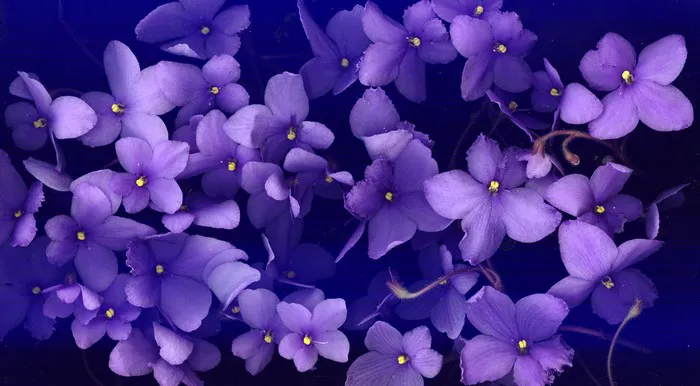Violet flowers, with their delicate petals and vibrant hues, have captivated humanity for centuries. Beyond their aesthetic appeal, these blooms carry profound symbolism across various cultures and contexts. From representing spirituality and intuition to embodying love and healing, the violet flower’s significance is as rich and diverse as its colors. In this article, we delve into the multifaceted symbolism of violet flowers, exploring their meanings, cultural significance, and the ways they inspire and resonate with us.
Historical and Cultural Significance
The symbolism of violet flowers traces back through history, intertwining with mythology, religion, and cultural traditions. In ancient Greece, violets were associated with the goddess Aphrodite and symbolized love and fertility. They were also linked to the god Zeus, representing his amorous pursuits. The poet Sappho famously described the violet as a symbol of lesbian love in her verses.
In Christianity, violet flowers took on a more somber symbolism, often associated with humility, penance, and mourning. During the Middle Ages, violet flowers were used in religious art to symbolize the humility of the Virgin Mary and the suffering of Christ. The violet’s modest appearance and its ability to thrive in shady, secluded areas contributed to its association with humility and modesty.
In Victorian England, where flowers were commonly used to convey sentiments and emotions, violets became popular symbols of faithfulness and devotion. Giving someone a bouquet of violets was a way to express loyalty and affection, particularly in romantic relationships.
Symbolism and Meanings
The symbolism of violet flowers encompasses a wide range of meanings, reflecting the complexities of human emotions and experiences. Some of the key symbolism associated with violets includes:
1. Spirituality and Intuition: Violets are often seen as symbols of spirituality and intuition. Their deep, mystical color and delicate fragrance evoke a sense of transcendence and inner wisdom. In many cultures, violets are believed to have healing properties and are used in spiritual practices to promote relaxation and meditation.
2. Modesty and Humility: The modest appearance of violet flowers has long been associated with qualities such as humility, modesty, and simplicity. Their unassuming beauty serves as a reminder to remain grounded and humble in the face of success or adversity.
3. Love and Devotion: Violets have been symbols of love and devotion for centuries. Whether exchanged between lovers or given as tokens of friendship, violets convey heartfelt emotions and a deep sense of connection. In the language of flowers, a bouquet of violets can express sentiments of affection, loyalty, and commitment.
4. Transformation and Rebirth: In some cultures, violets are seen as symbols of transformation and rebirth. Their ability to thrive in shady, secluded areas symbolizes resilience and the potential for growth even in challenging circumstances. Violets are often associated with springtime, a season of renewal and new beginnings.
5. Mourning and Remembrance: In certain contexts, violet flowers are used to symbolize mourning and remembrance. Their deep, solemn color and subtle fragrance make them suitable for commemorating loved ones and honoring their memory. In Victorian mourning rituals, violets were often included in funeral wreaths and arrangements as a symbol of eternal love and remembrance.
6. Femininity and Sensitivity: Violets have been traditionally associated with femininity and sensitivity, with their soft petals and delicate fragrance evoking qualities typically associated with womanhood. In literature and art, violets are often used to symbolize the feminine ideal and the nurturing aspects of motherhood.
7. Creativity and Inspiration: The vibrant color and enchanting fragrance of violet flowers have inspired artists, writers, and poets for centuries. Violets are often seen as symbols of creativity and inspiration, fueling the imagination and igniting the spark of artistic expression.
Cultural Variations
While the symbolism of violet flowers shares common themes across cultures, there are also variations in interpretation and meaning. In Japan, for example, violets are associated with modesty and humility, reflecting their delicate appearance and quiet beauty. In Chinese culture, violet flowers are symbols of harmony and peace, often used in traditional medicine and herbal remedies.
In Native American traditions, violets are seen as symbols of protection and healing, with their leaves and flowers used in ceremonial rituals and medicinal preparations. The Cherokee people, in particular, have a deep reverence for violets, using them as offerings to promote health and well-being.
In Islamic art and literature, violets are often depicted as symbols of beauty and purity, representing the divine qualities of love and compassion. The Persian poet Rumi frequently used violet imagery in his mystical verses, describing the flower as a metaphor for the soul’s journey towards spiritual enlightenment.
Modern Interpretations
In contemporary society, the symbolism of violet flowers continues to resonate with people, offering a source of inspiration, comfort, and connection. From bridal bouquets to funeral wreaths, violets are still used to convey sentiments of love, remembrance, and reverence. In the language of flowers, violets remain a timeless symbol of affection and devotion, cherished for their timeless beauty and profound meaning.
In popular culture, violets have been featured in literature, music, and art as symbols of love, longing, and nostalgia. In Tennessee Williams’ play “The Glass Menagerie,” the character Laura Wingfield collects glass figurines of violets, symbolizing her fragile and ephemeral beauty. In Claude Debussy’s piano composition “Clair de Lune,” the haunting melody evokes the ethereal beauty of moonlit violets, capturing the imagination of listeners around the world.
Conclusion
The symbolism of violet flowers is as diverse and enchanting as the blooms themselves. From ancient myths to modern interpretations, violets have captivated humanity with their beauty, fragrance, and profound meaning. Whether symbolizing love and devotion or humility and spirituality, violets continue to inspire and resonate with people across cultures and generations. As we admire the delicate petals and vibrant hues of these timeless flowers, let us reflect on the deeper symbolism they embody and the timeless truths they reveal about the human experience.


